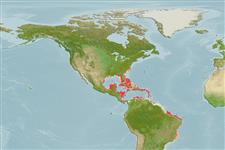Environment: milieu / climate zone / depth range / distribution range
Ecologie
marien; brak water rifbewoner. Subtropical
Western Atlantic: Bermuda, Florida Keys (USA), and Bahamas to northern South America. Scarce in western Gulf of Mexico (Ref. 26938).
Grootte / Gewicht / Leeftijd
Maturity: Lm ? range ? - ? cm
Max length : 15.0 cm TL mannelijk / geslacht onbekend; (Ref. 7251); 50.0 cm TL (female)
Korte beschrijving
Morfologie | Morfometrie
A very, slender, elongate, cylindrical eel with a projecting lower jaw. Lateral line complete ending at base of tail. (Ref. 26938).
Young and females burrow in sandy tide pools and reef tracts. Males inhabit deeper water, possibly pelagic. Adults emerge at night and sometimes come to lights at the surface (Ref. 26938). Feed on burrowing invertebrates that live in the sand (Ref. 26938).
Levenscyclus en paargedrag
Maturiteit | Voortplanting | Paaien | Eieren | Fecunditeit | Larven
Robins, C.R. and G.C. Ray, 1986. A field guide to Atlantic coast fishes of North America. Houghton Mifflin Company, Boston, U.S.A. 354 p. (Ref. 7251)
Status op de Rode Lijst van het IUCN (Ref. 130435)
Gevaar voor de mens
Harmless
Gebruik door de mens
Meer informatie
Lokale namenSynoniemenMetabolismePredatorenEcotoxicologieVoortplantingMaturiteitPaaienPaaiaggregatiesFecunditeitEierenOntwikkeling van de eieren
Leeftijd/GrootteGroeiLengte-gewichtLengte-lengteLengtefrequentiesMorfometrieMorfologieLarvenLarvale populatiedynamiekRekruteringAbundantieBRUVS
ReferentiesAquacultuurAquacultuurprofielKweeklijnenGeneticaElectrophoresesErfelijkheidZiektesVerwerkingNutrientsMassaconversie
Tools
Speciale rapporten
Download XML
Internetbronnen
Estimates based on models
Preferred temperature (Ref.
123201): 23.8 - 28.2, mean 27.3 °C (based on 786 cells).
Fylogenetische diversiteitsindex (Ref.
82804): PD
50 = 0.5003 [Uniqueness, from 0.5 = low to 2.0 = high].
Bayesian length-weight: a=0.00102 (0.00046 - 0.00225), b=3.06 (2.88 - 3.24), in cm total length, based on all LWR estimates for this body shape (Ref.
93245).
Trofisch niveau (Ref.
69278): 3.5 ±0.37 se; based on food items.
Fishing Vulnerability (Ref.
59153): Moderate vulnerability (40 of 100).
Nutrients (Ref.
124155): Calcium = 50 [20, 135] mg/100g; Iron = 0.584 [0.290, 1.102] mg/100g; Protein = 19.1 [16.8, 21.6] %; Omega3 = 0.203 [0.081, 0.560] g/100g; Selenium = 10.4 [4.1, 25.2] μg/100g; VitaminA = 114 [26, 489] μg/100g; Zinc = 1.4 [0.8, 2.2] mg/100g (wet weight);
